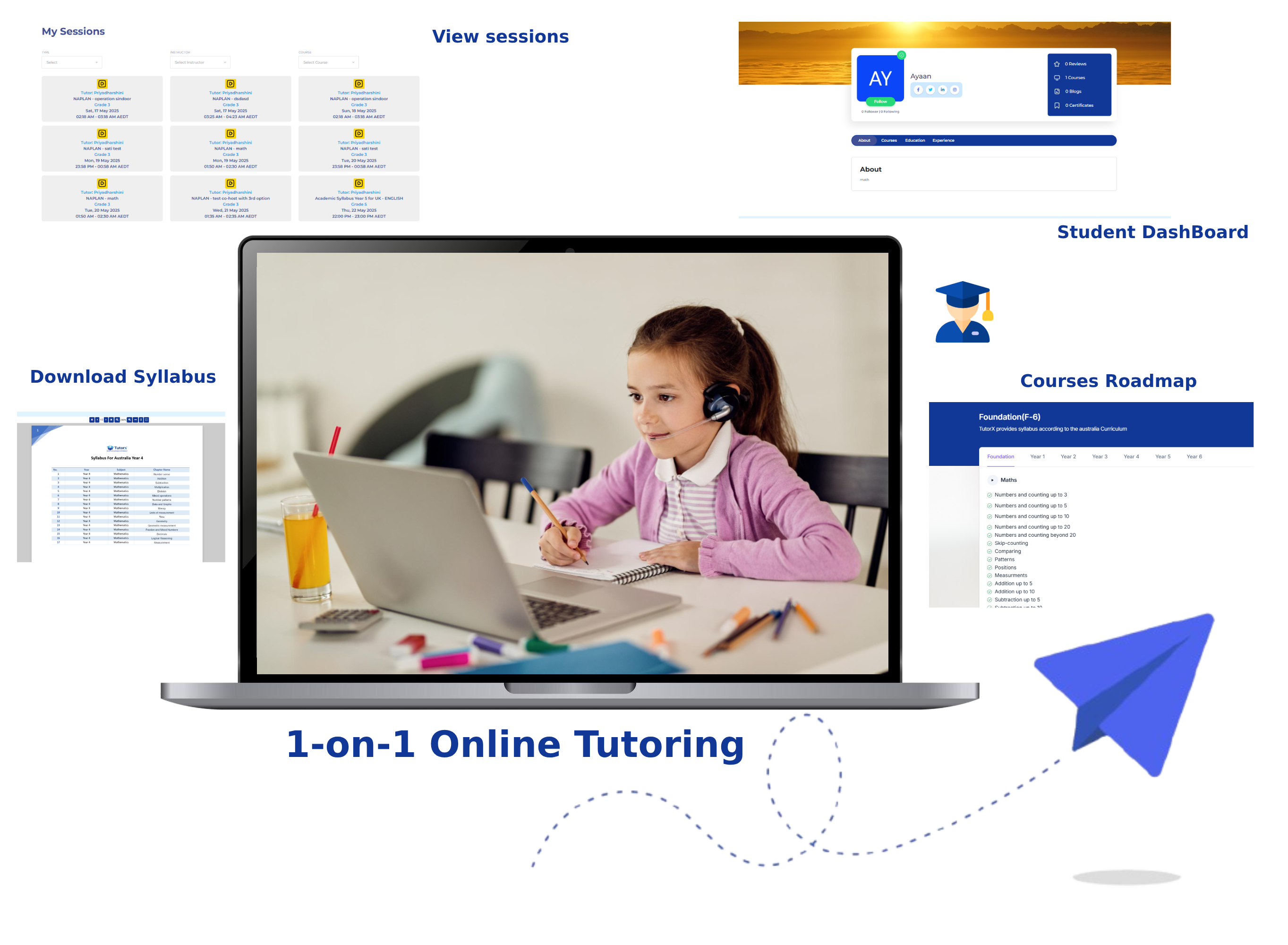Book a free trial session and start your personalized learning journey with our expert tutors.
Fill out the form below and one of our experts will contact you shortly.
Everything You Need, All in One Place
At The TutorX, we believe learning should be clear, focused, and at your fingertips. That’s why we’ve built a smart and user-friendly dashboard to empower every student on their academic journey. From live sessions and homework to performance tracking and resources—everything is seamlessly integrated to help you stay ahead with confidence.

In New South Wales (NSW), selective high schools are public institutions designed to cater to high-potential and gifted students by providing an environment that fosters academic excellence. These schools offer a cost-effective alternative to private education, delivering high-quality learning experiences without the substantial fees associated with private schools.

In New South Wales (NSW), students in Year 6 (typically aged 11–12) participate in the Selective High School Placement Test. These students sit the test to gain entry into Year 7 at a selective high school the following year.
To place academically gifted students into Selective High Schools for advanced learning opportunities.
Year 6 students take the test for placement in Year 7 Selective High Schools.
Strong academic performance, usually reflected in high grades and teacher recommendations and high achievement in core subjects (English, Mathematics, etc.).
| Test Component | No. of Questions | Time | Main Test Period | Make-up Test Date |
|---|---|---|---|---|
| Reading Test | 30 | 40 minutes | 2 May – 4 May 2025 | 19 May 2025 |
| Mathematical Reasoning Test | 35 | 40 minutes | 2 May – 4 May 2025 | 19 May 2025 |
| Thinking Skills Test | 40 | 40 minutes | 2 May – 4 May 2025 | 19 May 2025 |
| Writing Test | 1 (Open response) | 30 minutes | 2 May – 4 May 2025 | 19 May 2025 |
The score is determined by combining the test results with school assessment scores. The possible outcomes include:
Offer: A student is offered a place at a selective school. Parents must accept or decline.
Reserved List: Students are placed on a waiting list and may receive an offer if a spot opens.
Unsuccessful: Student was not selected and is not on the reserve list.
Fully Selective Schools: Entirely dedicated to academically gifted students.
Partially Selective Schools: Offer both selective and non-selective streams.
Agricultural High Schools: Include a boarding component with selective academic streams.
The Reading section of the Selective Placement Test assesses a range of reading skills using a variety of texts. Candidates will encounter fiction extracts, factual texts, poetry, magazine articles, and traditional tales. The selection includes works from Australian literature, including Aboriginal cultures, as well as international authors.Candidates must complete 30 questions in 40 minutes. All questions are equally weighted, and there are no penalties for incorrect answers.
| Part | Text Type | Question Format | Number of Questions |
|---|---|---|---|
| Part 1 | Narrative or descriptive fiction extract OR two short extracts on a related theme (one historical, one modern) | 4-option multiple choice | 8 |
| Part 2 | A poem | 4-option multiple choice | 6 |
| Part 3 | Factual text with six sentences removed OR factual text divided into paragraphs with summary phrases | Matching | 6 |
| Part 4 | Four short texts on a related theme | 4-option multiple choice | 10 |
This part includes either a comprehension task based on a single piece of fiction or a comparison task between two thematically linked texts (one historical, one modern). Questions may assess:
Stylistic features and word meanings in context
Implied meaning and language effects
Author’s purpose, opinions, attitudes, and text structure.
Candidates analyze a short poem, focusing on:
The effect of stylistic features (e.g., imagery, metaphor).
Implicit meaning, structure, and the poet’s intent.
Candidates complete one of two tasks: Questions may assess:
Gap Match – Selecting the correct missing sentences to maintain text flow.
Summary Phrases – Matching summary phrases to paragraphs to assess main idea recognition.
Candidates analyze four short, thematically linked extracts from sources such as blogs, reports, reviews, and articles. Questions focus on:Questions may assess:
Extracting key information quickly.
Understanding implied meaning, tone, and style.
The Mathematical Reasoning section evaluates a candidate’s ability to apply mathematical thinking and problem-solving skills rather than simply testing curriculum content. Candidates must answer 35 multiple-choice questions in 40 minutes. Each question presents five answer options (A–E). While no advanced content knowledge is required, all questions are designed to align with the NSW K-10 Syllabus for Stages 1, 2, and the first half of Stage 3 (Years 1-5).This section assesses: Logical and analytical reasoning , Number sense and numerical operations , Pattern recognition and spatial reasoning ,Problem-solving and application of concepts.
| Question Type | Example Concepts |
|---|---|
| Number Operations | Place value, number sequences, arithmetic reasoning |
| Patterns & Algebra | Identifying number patterns, missing numbers, simple algebraic thinking |
| Geometry & Measurement | Shapes, nets, perimeter, area, volume |
| Data & Statistics | Interpreting charts, graphs, probability |
| Word Problems | Applying logic to real-world numerical problems |
The Thinking Skills section assesses a candidate’s ability to analyze, evaluate, and apply logical reasoning across different types of problems. It consists of 40 multiple-choice questions, each with four answer options (A–D). This section focuses on generic academic skills rather than specific subject knowledge. It includes verbal, spatial, and numerical reasoning challenges, testing the candidate’s ability to: Identify patterns and similarities ,Apply logical reasoning and problem-solving ,Evaluate evidence and reasoning ,Detect mistakes in arguments.
| Question Type | Skill Assessed | Example Concepts |
|---|---|---|
| Identifying Similarity | Pattern Recognition | Recognizing patterns in shapes, numbers, and words |
| Finding Procedures | Problem Solving | Multi-step problem-solving using given data |
| Evaluating Evidence | Critical Thinking | Strengthening or weakening an argument with additional information |
| Evaluating Reasoning | Logical Reasoning | Identifying valid and invalid logical conclusions |
| Identifying Mistakes | Error Detection | Spotting logical errors in statements or arguments |
| Logical Analysis | Analytical Thinking | Understanding cause-effect relationships and making deductions |
The Writing section evaluates a broad range of essential writing skills. Candidates are required to complete one writing task within a 30-minute time frame, which includes time for planning and reviewing their work. The task may involve producing a piece in various formats, such as an email, report, diary entry, story, or newspaper article. This section is designed to assess a candidate’s ability to perform a variety of writing functions. These include narrating a story, explaining a concept, describing a scene or idea vividly, informing the reader with factual content, advising by offering suggestions, and persuading the audience with compelling arguments. Topics used in the Writing section are familiar and engaging, encouraging students to draw upon their own experiences and creativity. This ensures that while academic writing skills are tested, students also have the opportunity to showcase their personal voice and imagination.
| Criteria Set | Marks | Assessment Focus | Example Indicators |
|---|---|---|---|
| Set A: Content, Form & Style | 15 Marks | Ideas, Structure, Tone, Relevance |
✅ Selecting relevant, interesting content ✅ Writing in the correct format ✅ Organizing ideas logically ✅ Using paragraphs and cohesive devices ✅ Adopting an appropriate tone & vocabulary |
| Set B: Sentences & Accuracy | 10 Marks | Grammar, Mechanics, Sentence Structure |
✅ Using a variety of sentence structures ✅ Using correct punctuation ✅ Spelling words correctly |
Administrator

Lorem Ipsum is simply dummy text of the printing and typesetting industry. Lorem Ipsum has been the industry's standard dummy text ever since the 1500s, when an unknown printer took a galley of type and scrambled it to make a type specimen book.
Lorem Ipsum is simply dummy text of the printing and typesetting industry. Lorem Ipsum has been the industry's standard dummy text ever since the 1500s, when an unknown printer took a galley of type and scrambled it to make a type specimen book. It has survived not only five centuries, but also the leap into electronic typesetting, remaining essentially unchanged. It was popularised in the 1960s with the release of Letraset sheets containing Lorem Ipsum passages, and more recently with desktop publishing software like Aldus PageMaker including versions of Lorem Ipsum.
Reach out to TutorX your questions spark the path to smarter learning
